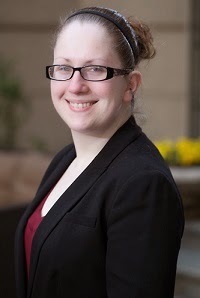Event Recap: Dr. Sarah Martin, ASBMB Science Policy Fellow
by Ian McLaughlin
On February 11th, Dr. Sarah Martin, a Science
Policy Fellow at the American Society for Biochemistry and Molecular Biology
(ASBMB), visited Penn to chat about her experience working in science policy.
As it turns out, her story is perhaps more circuitous than one might expect.
An
avid equestrian, Sarah earned a bachelor’s degree in animal sciences and a master’s
degree in animal nutrition at the University of Kentucky before embarking on a
Ph.D. in Molecular and Cellular Biochemistry at UK’s College of Medicine. While
pursuing her degrees, Sarah realized that the tenure track was not for her, and
she began exploring career options using the Individual Development Plan (IDP)
provided by AAAS Careers. At the
top of the list: science policy.
With an exciting career option in mind, Sarah sought ways to
build “translatable skills” during her Ph.D. to help her move toward science
policy. She served as treasurer, and later Vice President, of UK’s Graduate
Student Congress and developed her communication skills by starting her own blog
and participating in ThreeMinute Thesis. Sarah stressed the
importance of communicating with non-scientists, and she highlighted how her
practice paid off during Kentucky’s first-ever State Capitol Hill Day, an event
that showcases Kentucky-focused scientific research to that state’s
legislators.
Sarah also shared how she got up to speed
on science policy issues, becoming a “student of policy” by voraciously reading
The Hill,
RollCall, Politico, ScienceInsider, and ASBMB’s own PolicyBlotter. Additionally, she started to engage with peers,
non-scientists, and legislators on Twitter, noting how it’s a useful tool to sample
common opinions on issues related to science.
Finally, she reached out to former ASBMB fellows for advice on how to
pursue a career in science policy – and they were happy to help.
Sarah then described the
typical responsibilities of an ASBMB fellow, breaking them down into four categories:
- Research- tracking new legislation, and a daily diet of articles regarding new developments in science and policy
- Meetings- with legislators on Capitol Hill, staff at the NIH, partner organizations such as the Federation of American Societies for Experimental Biology (FASEB), and others
- Writing- white papers, position statements, and blog posts on everything from ASBMB’s position on gene editing to the NIH Strategic Plan for FY 2016-2020
- Administration- organizing and preparing for meetings, composing executive summaries, and helping to plan and organize ASBMB’s Hill Day.
Sarah also talked about her own independent project
at ASBMB, a core component of each Fellowship experience. Sarah aims to update ASBMB’s
Advocacy Toolkit in order to consolidate all of the resources a scientist might
need to engage in successful science advocacy.
Comparing the ASBMB fellowship to similar fellowships, she
noted as an advantage that there is no specific end to the fellowship, which gives Fellows plenty of time to find permanent positions that match their
interests. Sarah also noted that, compared
to graduate students and postdocs, she enjoys an excellent work/life balance.
Ultimately, Sarah made it clear that she loves what she does.
She closed by providing the following resources from ASBMB Science Policy
Analyst Chris Pickett for anyone interested in applying for the ASBMB
fellowship or pursuing a career in science policy:
- ‘I didn’t even know what skills I needed for a career inscience policy’
- ‘A day in the life of the ASBMB science policy fellow’
- ‘The skills you need for a career in science policy’

This comment has been removed by a blog administrator.
ReplyDelete